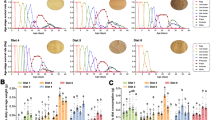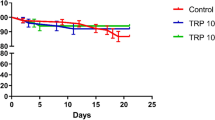Abstract
INGESTION of proteinaceous but not of non-proteinaceous foods is followed by an increased level of proteolytic enzymes in the midgut of Aedes aegypti1,2 and Leucophaea maderae3,4 as well as in other insect species. Two hypotheses have been advanced to explain the mechanism by which certain foods cause enzyme synthesis and/or release into the gut lumen: (a) certain foods might act as secretagogues, that is, chemicals which elicit enzyme synthesis in the gut cells with which they come in contact, or (b) food intake might trigger the release of hormones which in turn stimulate enzyme synthesis. We tested these two proposed mechanisms with the fleshfly Sarcophaga.
This is a preview of subscription content, access via your institution
Access options
Subscribe to this journal
Receive 51 print issues and online access
$199.00 per year
only $3.90 per issue
Buy this article
- Purchase on SpringerLink
- Instant access to full article PDF
Prices may be subject to local taxes which are calculated during checkout
Similar content being viewed by others
References
Fisk, F. W., Ann. Entomol. Soc. Amer., 43, 555 (1950).
Shambaugh, G. F., Ohio J. Sci., 54, 151 (1954).
Engelmann, F., Naturwissenschaften, 53, 113 (1966).
Engelmann, F. J., Insect Physiol., 15, 271 (1969).
Lowry, O. H., Rosenbrough, N. J., Farr, A. L., and Randall, R. J., J. Biol. Chem., 193, 267 (1951).
Duspiva, F., Protoplasma, 32, 209 (1939).
Thomsen, E., and Møller, I., Nature, 183, 1401 (1959).
Thomsen, E., and Møller, I., J. Exp. Biol., 40, 301 (1963).
Author information
Authors and Affiliations
Rights and permissions
About this article
Cite this article
ENGELMANN, F., WILKENS, J. Synthesis of Digestive Enzyme in the Fleshfly Sarcophaga bullata stimulated by Food. Nature 222, 798 (1969). https://doi.org/10.1038/222798a0
Received:
Revised:
Issue Date:
DOI: https://doi.org/10.1038/222798a0



